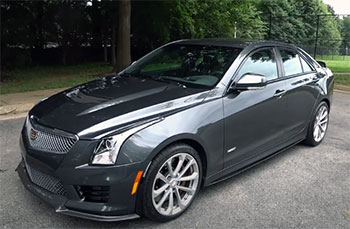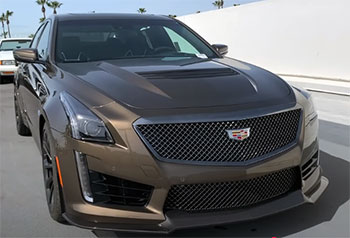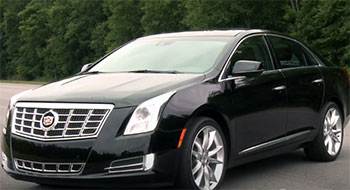I’ve always been drawn to Cadillac’s blend of American luxury and performance, so when I set out to compare the ATS, CTS, and XTS, I wanted to experience what makes each sedan unique. My goal was to understand their strengths, weaknesses, and personalities from behind the wheel. In this article, I’ll share my firsthand insights, breaking down the pros and cons of each model, comparing their key features, and answering common questions to help you decide which Cadillac suits your lifestyle. Whether you’re after sporty handling, spacious comfort, or raw power, I’ve got you covered.
Comparison Table: Cadillac ATS vs. Cadillac CTS vs. Cadillac XTS
| Feature | Cadillac ATS | Cadillac CTS | Cadillac XTS |
|---|---|---|---|
| Size | Compact sedan/coupe | Midsize sedan | Full-size sedan |
| Base Engine | 2.0L Turbo 4-cylinder (272 hp) | 2.0L Turbo 4-cylinder (268 hp) | 3.6L V6 (304 hp) |
| Top Engine | 3.6L V6 (335/464 hp in ATS-V) | 6.2L V8 (640 hp in CTS-V) | 3.6L Twin-Turbo V6 (410 hp) |
| Drivetrain | RWD, optional AWD | RWD, optional AWD | FWD, optional AWD |
| Transmission | 6-speed manual or 8-speed automatic | 6-speed or 8-speed automatic | 6-speed automatic |
| Fuel Economy (City/Hwy) | 20/29 MPG (2.0T, RWD, auto) | 20/30 MPG (2.0T, RWD, auto) | 17/26 MPG (3.6L, FWD) |
| Trunk Space | 10.4 cu ft | 13.7 cu ft | 18.0 cu ft |
| Front Legroom | 42.5 inches | 45.7 inches | 45.8 inches |
| Rear Legroom | 33.5 inches | 35.4 inches | 40.0 inches |
| Base Price (2018) | ~$35,000 | ~$46,000 | ~$47,000 |
| Target Driver | Sporty, enthusiast-focused | Balanced luxury and performance | Comfort-oriented, traditional luxury |
My Experience With the Cadillac ATS

Sliding into the driver’s seat of the Cadillac ATS felt like stepping into a sports car dressed in a tuxedo.
This compact sedan (or coupe, if you go that route) is Cadillac’s answer to the BMW 3 Series, and it’s clear from the first turn that it’s built for drivers who love to carve corners.
I tested a 2018 ATS with the 2.0L turbo four-cylinder and a six-speed manual—a rare treat in the luxury segment.
The steering was razor-sharp, and the chassis felt nimble, almost begging me to push it harder on winding roads.
The interior, while snug, wrapped me in premium leatherette and sleek chrome accents, though the back seat reminded me this isn’t a family hauler. Parking in tight city spots was a breeze, and the ATS’s compact size made it feel agile in traffic.
But on longer highway drives, I noticed the ride could feel a bit firm, and the engine, while punchy, lacked the refinement of the larger V6 options. The CUE infotainment system, with its 8-inch touchscreen, was intuitive enough, but I fumbled with the touch-sensitive controls more than I’d like.
The ATS-V, with its 464-horsepower twin-turbo V6, was a different beast entirely. I took one for a spin at a track event, and the acceleration pinned me to the seat, while the Magnetic Ride Control kept everything composed.
It’s a car that thrives on enthusiasm but sacrifices some practicality. If you’re after a driver’s car with Cadillac flair, the ATS delivers, but it’s not without compromises, especially if you need space or a softer ride.
Read More: My Thoughts On Acura MDX Vs. Volvo XC90
Pros Of the Cadillac ATS
- Sporty Handling: The ATS’s tight steering and lightweight chassis make it a joy on twisty roads, rivaling European compacts like the BMW 3 Series. It feels alive and responsive, especially in the ATS-V trim.
- Manual Transmission Option: A six-speed manual is available, a rarity in luxury sedans, offering a pure, engaging drive for enthusiasts like me who love shifting gears.
- Compact Size: At 13 inches shorter than the CTS, it’s easy to maneuver in urban environments, making parallel parking less of a chore.
- Strong Base Engine: The 2.0L turbo four-cylinder delivers 272 horsepower with solid acceleration, hitting 0-60 mph in about 5.5 seconds in RWD models.
- Modern Design: The ATS’s sharp lines and LED-lit accents give it a contemporary, aggressive look that stands out in the luxury compact class.
- Technology Suite: Standard Apple CarPlay, Android Auto, and OnStar 4G LTE Wi-Fi keep you connected, though the CUE system takes some getting used to.
Cons Of the Cadillac ATS
- Cramped Rear Seat: With only 33.5 inches of rear legroom, the back seat is tight for adults, making it less ideal for frequent passengers.
- Firm Ride: The sporty suspension can feel harsh on rough roads, which I noticed during longer drives over potholed streets.
- Small Trunk: At 10.4 cubic feet, the trunk is one of the smallest in its class, limiting cargo space for road trips or groceries.
- Base Engine Noise: The 2.0L turbo, while powerful, sounds coarse under hard acceleration compared to the smoother V6 options.
- CUE System Frustrations: The touch-sensitive controls for climate and audio were finicky, often requiring multiple taps to register inputs.
- Discontinued Model: Production ended in 2018, so you’re limited to used options, which may affect long-term support and resale value.
My Experience With the Cadillac CTS

The Cadillac CTS struck me as the Goldilocks of the trio—not too small, not too big, but just right for those wanting a balance of luxury and performance.
I drove a 2018 CTS with the 3.6L V6, producing 335 horsepower, paired with an eight-speed automatic.
The midsize sedan felt planted yet refined, with enough power to merge confidently onto highways and a suspension that soaked up bumps better than the ATS.
The interior was a step up, with more room to stretch out (45.7 inches of front legroom) and a richer design featuring wood trim and detailed stitching.
The Magnetic Ride Control, available on higher trims, made the ride feel like it was gliding over imperfections, yet it still handled corners with poise.
The CTS-V, with its monstrous 640-horsepower supercharged V8, was a revelation. I took one through a mountain pass, and the sheer thrust was exhilarating, though it’s overkill for daily driving. The back seat offered decent space for adults, and the 13.7-cubic-foot trunk swallowed my weekend bags easily.
However, the CTS’s higher price tag and the same clunky CUE system as the ATS were minor drawbacks. For drivers wanting a do-it-all luxury sedan, the CTS feels like the sweet spot, blending comfort, space, and performance without leaning too far in any one direction.
Pros Of the Cadillac CTS
- Balanced Performance: The CTS offers a smooth blend of sporty handling and refined ride quality, thanks to Magnetic Ride Control and a choice of powerful engines.
- Spacious Interior: With 35.4 inches of rear legroom and 13.7 cubic feet of trunk space, it’s practical for families or long trips.
- Potent Engine Options: From the 268-hp 2.0L turbo to the 640-hp V8 in the CTS-V, there’s an engine for every driving style.
- Luxurious Cabin: Premium materials like leather, wood, and chrome create an upscale vibe, rivaling German competitors.
- Advanced Safety Features: Available adaptive cruise control, lane keep assist, and automatic braking enhance driver confidence.
- All-Wheel Drive Option: AWD improves traction in adverse conditions, making it a versatile choice for varied climates.
Cons Of the Cadillac CTS
- Higher Price Point: Starting around $46,000 in 2018, it’s pricier than the ATS, which may stretch budgets for some buyers.
- CUE System Issues: Like the ATS, the touch-sensitive infotainment controls were frustrating, often lagging or misregistering inputs.
- Fuel Economy: The base 2.0L turbo gets 20/30 MPG, but V6 and V8 models are thirstier, especially in city driving.
- Discontinued in 2019: No new models are available, potentially impacting parts availability and resale value over time.
- Less Agile Than ATS: While sporty, the CTS’s larger size makes it less nimble than the ATS in tight corners.
- Complex Trim Levels: Multiple engine and trim options can make choosing the right CTS model overwhelming for first-time buyers.
My Experience With the Cadillac XTS

The Cadillac XTS felt like stepping into a modern take on the classic Cadillac experience—big, plush, and built for comfort.
I drove a 2019 XTS with the 3.6L V6, producing 304 horsepower, and its front-wheel-drive layout gave it a different character from the sportier ATS and CTS.
The ride was buttery smooth, almost floating over bumps, which made long highway drives a pleasure.
The cabin was cavernous, with 40 inches of rear legroom and an 18-cubic-foot trunk that easily handled luggage for a weekend getaway.
The interior screamed luxury, with soft leather and a Bose sound system that made every song sound like a live performance.
However, the XTS wasn’t without flaws. Its size made it less agile in tight spaces, and the base V6, while adequate, didn’t excite like the turbo engines in the ATS or CTS. The twin-turbo V6 option, with 410 horsepower, added some pep but felt out of place in this comfort-focused sedan.
The CUE system, again, was a pain point, and the XTS’s styling felt less modern than its siblings. For buyers prioritizing space and a traditional luxury experience, the XTS delivers, but it’s not the choice for those craving sporty dynamics.
Pros Of the Cadillac XTS
- Spacious Interior: With 40 inches of rear legroom and 45.8 inches up front, it’s ideal for families or those who prioritize passenger comfort.
- Huge Trunk: The 18-cubic-foot trunk is class-leading, perfect for road trips or hauling large items.
- Smooth Ride: The XTS glides over rough roads, offering a cushioned, traditional Cadillac experience.
- Luxury Features: Standard dual-zone climate control, Bose audio, and available heated seats create a premium cabin.
- All-Wheel Drive Option: AWD enhances grip in snow or rain, making it a solid choice for inclement weather.
- Reliable Base Engine: The 3.6L V6 delivers 304 horsepower with decent fuel economy (17/26 MPG) for a full-size sedan.
Cons Of the Cadillac XTS
- Less Sporty: The XTS prioritizes comfort over agility, feeling less engaging than the ATS or CTS on twisty roads.
- Outdated Styling: Compared to the sharper ATS and CTS, the XTS’s design feels less modern and distinctive.
- CUE System Woes: The infotainment system’s touch-sensitive controls are clunky and detract from the luxury experience.
- Front-Wheel Drive Bias: Standard FWD feels less dynamic than the RWD-based ATS and CTS, even with AWD.
- Twin-Turbo Reliability: The 410-hp twin-turbo V6 has reported reliability issues, making the base engine a safer bet.
- Discontinued in 2019: Like its siblings, the XTS is no longer in production, potentially affecting long-term value.
Analyzing the Cadillac Trio
Each Cadillac sedan has a distinct personality, shaped by its size, drivetrain, and target audience. The ATS is the scrappy underdog, built for enthusiasts who crave sharp handling and don’t mind a compact footprint. Its 2.0L turbo engine and available manual transmission make it a driver’s car, but the tight rear seat and small trunk limit its versatility. I found it exhilarating on backroads but less practical for family duties or long hauls.
The CTS, to me, is the most well-rounded. Its midsize dimensions offer enough space for passengers and cargo while maintaining sporty credentials. The range of engines, from the efficient 2.0L turbo to the fire-breathing 640-hp V8 in the CTS-V, gives it broad appeal. During my drives, it struck a balance between comfort and performance, though its higher price and finicky CUE system were noticeable drawbacks.
The XTS, meanwhile, is the traditionalist’s choice. Its full-size proportions and plush ride cater to those who value comfort above all else. I appreciated the cavernous interior and smooth highway manners, but its less dynamic handling and dated styling made it feel like a step behind its siblings. The XTS is for buyers who want a luxurious cruiser, not a corner-carver.
When comparing performance, the ATS and CTS have the edge with their rear-wheel-drive platforms and sportier tuning. The ATS-V and CTS-V are performance beasts, with the latter’s 640 horsepower outpacing most rivals. The XTS, with its front-wheel-drive base and softer suspension, prioritizes a relaxed ride over agility. Fuel economy is similar across the trio, with the ATS and CTS slightly better (20/29-30 MPG) than the XTS (17/26 MPG), though higher trims and V6/V8 engines reduce efficiency.
Interior quality is a Cadillac hallmark, and all three deliver premium materials, but the CTS and XTS feel more upscale than the ATS’s snug cabin. Technology, like the CUE system, is a mixed bag—feature-rich but frustrating to use. Safety features, including adaptive cruise control and automatic braking, are available across the board, though more standard on higher trims of the CTS and XTS.
Price-wise, the ATS was the most affordable, starting around $35,000 in 2018, followed by the CTS at $46,000 and the XTS at $47,000. However, their discontinued status means you’ll be shopping used, where prices vary based on condition and mileage. The ATS and CTS hold appeal for performance enthusiasts, while the XTS targets comfort-seekers.
Read More: My Thoughts On Acura MDX Vs. Lexus GX
Frequently Asked Questions (FAQ)
The ATS is better for sporty driving and agility, ideal for enthusiasts, while the XTS excels in comfort and space, perfect for families or relaxed cruising. Choose based on your priorities: performance (ATS) or luxury (XTS).
The CTS is better for balanced performance and luxury, offering sporty handling and a roomy interior. The XTS prioritizes comfort and space but lacks dynamism. Pick the CTS for versatility, XTS for a plush ride.
The CTS is better for most buyers, offering more space, refinement, and engine options, including the powerful CTS-V. The ATS is sportier but cramped. Choose the CTS for practicality, ATS for pure driving fun.
XTS doesn’t officially stand for anything specific; it’s a model designation meant to evoke luxury and prestige, continuing Cadillac’s tradition of three-letter names like CTS and ATS.
Conclusion: For You, the Cadillac Buyer
You’re probably wondering which of these Cadillacs is the right fit for your life. If you’re a driving enthusiast who loves tight corners and a manual gearbox, the ATS will put a grin on your face, though you’ll sacrifice space. If you want a sedan that does it all—comfort, performance, and practicality—the CTS is your best bet, balancing luxury with power. And if you crave a spacious, smooth-riding cruiser for long trips or family duties, the XTS delivers that classic Cadillac vibe. Test-drive them, feel their personalities, and you’ll know which one speaks to you.

